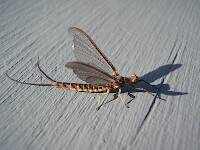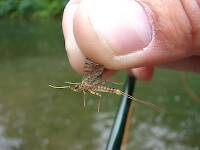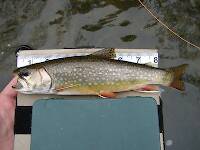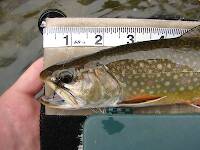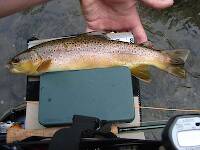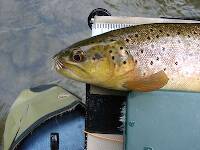
Hex Mayflies
Hexagenia limbata
The famous nocturnal Hex hatch of the Midwest (and a few other lucky locations) stirs to the surface mythically large brown trout that only touch streamers for the rest of the year.
Featured on the forum

As far as I can tell, this species has only previously been reported from one site in Oregon along the Columbia gorge. However, the key characteristics are fairly unmistakable in all except for one minor detail:
— 4 small yellow spots on frons visible in photos
— Narrow occipital spinule row curves forward (but doesn’t quite meet on stem of ecdysial suture, as it's supposed to in this species)
— Short spinules on anterior margin of front legs
— Short rposterior row of blunt spinules on abdominal tergae, rather than elongated spinules dorsally
I caught several of these mature nymphs in the fishless, tiny headwaters of a creek high in the Wenatchee Mountains.
— 4 small yellow spots on frons visible in photos
— Narrow occipital spinule row curves forward (but doesn’t quite meet on stem of ecdysial suture, as it's supposed to in this species)
— Short spinules on anterior margin of front legs
— Short rposterior row of blunt spinules on abdominal tergae, rather than elongated spinules dorsally
I caught several of these mature nymphs in the fishless, tiny headwaters of a creek high in the Wenatchee Mountains.

Troutnut is a project started in 2003 by salmonid ecologist Jason "Troutnut" Neuswanger to help anglers and
fly tyers unabashedly embrace the entomological side of the sport. Learn more about Troutnut or
support the project for an enhanced experience here.
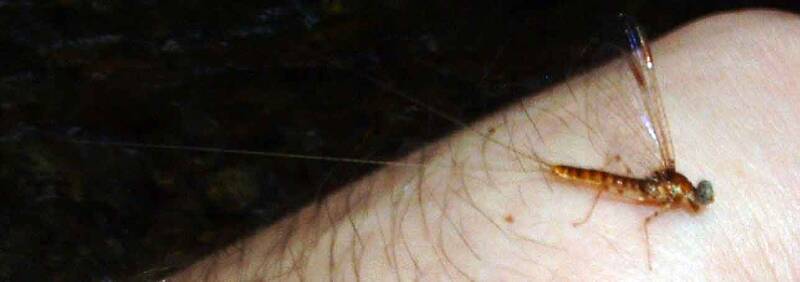
CouxJoe on May 16, 2007May 16th, 2007, 10:40 am EDT
First picture posting... sorry if it's not up to snuff. Thanks for the i.d.!
Taxon on May 16, 2007May 16th, 2007, 12:42 pm EDT
Joe-
Given the focus of the photo, identification is problematic. Having said that, my guess would be a Maccaffertium vicarium male spinner missing its forelegs. However, you have (11) separate Maccafertium species in N. Carolina, many of which haven't attracted the interest of flyfishing entomology authors.
Given the focus of the photo, identification is problematic. Having said that, my guess would be a Maccaffertium vicarium male spinner missing its forelegs. However, you have (11) separate Maccafertium species in N. Carolina, many of which haven't attracted the interest of flyfishing entomology authors.
CouxJoe on May 16, 2007May 16th, 2007, 1:29 pm EDT
Thank you for your reply,
Any suggestions on angle/angles that I should try to shoot next time to help in identification?
Thanks again!
Any suggestions on angle/angles that I should try to shoot next time to help in identification?
Thanks again!
Taxon on May 16, 2007May 16th, 2007, 1:40 pm EDT
Joe-
The angle is ideal. It's just that the photo is either out or focus and/or has insufficient resolution to blow up and see the necessary detail.
The angle is ideal. It's just that the photo is either out or focus and/or has insufficient resolution to blow up and see the necessary detail.
Taxon on May 16, 2007May 16th, 2007, 9:05 pm EDT
Joe-
Given the focus of the photo, identification is problematic. Having said that, my guess would be a Maccaffertium vicarium male spinner missing its forelegs. However, you have (11) separate Maccafertium species in N. Carolina, many of which haven't attracted the interest of flyfishing entomology authors.
Come on now, guys. Doesn’t anyone have some healthy rebuttal? Please don't disappoint me like this!
Quillgordon on May 16, 2007May 16th, 2007, 11:39 pm EDT
Come on now, guys. Doesn’t anyone have some healthy rebuttal? Please don't disappoint me like this!
Roger....
Who is going to rebutt you??? .....LOL....
Does this critter really have a green head/eyes ?
I looked at Jason's photos..... it looks like M.vicarium to me, but I'm not an entomologists....... FWIW.
What does 'vicarium' mean???
Since we are dealing with Latin names, as opposed to common names like 'march brown'; can you give us a link to a Latin/English translation? I searched for one, but didn't find one!
Thanks,
John
Flyfishing is a state of mind! .............. Q.g.
C/R........barbless
C/R........barbless
Taxon on May 17, 2007May 17th, 2007, 4:46 am EDT
John-
Hopefully we will see.
The Biology Of Mayflies described one of the Maccaffertium vicarium synonyms, Stenonema rivulicolum as having eyes which are "pale gray with greenish tinge." The eyes appear sort of a pea green on my monitor. Perhaps CouxJoe can tell us whether the photo effectively captured the actual eye color.
I believe it refers to the parish of a vicar. Perhaps Louis will know the etymology.
Who is going to rebutt you?
Hopefully we will see.
Does this critter really have a green head/eyes?
The Biology Of Mayflies described one of the Maccaffertium vicarium synonyms, Stenonema rivulicolum as having eyes which are "pale gray with greenish tinge." The eyes appear sort of a pea green on my monitor. Perhaps CouxJoe can tell us whether the photo effectively captured the actual eye color.
What does 'vicarium' mean?
I believe it refers to the parish of a vicar. Perhaps Louis will know the etymology.
Quillgordon on May 17, 2007May 17th, 2007, 5:15 am EDT
I believe it refers to the parish of a vicar. Perhaps Louis will know the etymology.
What does that have to do with this particular insect???
I know the names are to honor the discoverer(McCafferty), but where does the 'vicarium' come into play.This is why FF's are more comfortable using common names like 'march brown', or 'gray fox'.
I don't see the word 'vicarium' in English or Latin dictionarys.
Is there a light at the end of the tunnel........ other than a 'fast moving train' ???
Someone should write a book called 'Entomology names made easy!'
Flyfishing is a state of mind! .............. Q.g.
C/R........barbless
C/R........barbless
GONZO on May 17, 2007May 17th, 2007, 6:29 am EDT
John,
The eyes of some mayflies (esp. Heptageniidae) turn fluorescent shades of green or blue when exposed to bright light. They are normally dark when the insect first emerges (and return to that in the absence of light).
As for the meaning of "vicarium," the original name of this species was Baetis vicaria (Walker, 1853). It went through other variations--vicarius, vicarium--as the assigned genus was changed over the years. (I assume the endings changed to provide gender agreement with the new genus names.) One would have to go back to Walker to provide a definitive etymology. Like the words "vicar" and "vicarious," I assume it carries the sense of "replacement," "representative," or "substitute."
The common name, March brown, is borrowed from the name of a famous British mayfly that it resembled and that did begin emerging in March (unlike the American version). Perhaps the name refers to this New World substitute or replacement for that mayfly. (?)
Roger,
The picture is just too fuzzy for me to quibble with your guess. (Sorry.)
Does this critter really have green head/eyes?
The eyes of some mayflies (esp. Heptageniidae) turn fluorescent shades of green or blue when exposed to bright light. They are normally dark when the insect first emerges (and return to that in the absence of light).
As for the meaning of "vicarium," the original name of this species was Baetis vicaria (Walker, 1853). It went through other variations--vicarius, vicarium--as the assigned genus was changed over the years. (I assume the endings changed to provide gender agreement with the new genus names.) One would have to go back to Walker to provide a definitive etymology. Like the words "vicar" and "vicarious," I assume it carries the sense of "replacement," "representative," or "substitute."
The common name, March brown, is borrowed from the name of a famous British mayfly that it resembled and that did begin emerging in March (unlike the American version). Perhaps the name refers to this New World substitute or replacement for that mayfly. (?)
Roger,
The picture is just too fuzzy for me to quibble with your guess. (Sorry.)
Quillgordon on May 17, 2007May 17th, 2007, 8:37 am EDT
The common name, March brown, is borrowed from the name of a famous British mayfly that it resembled and that did begin emerging in March (unlike the American version). Perhaps the name refers to this New World substitute or replacement for that mayfly. (?)
Ok..... I see a possible(?) connection there !
Roger,
The picture is just too fuzzy for me to quibble with your guess. (Sorry.)
We want you to 'quibble'(?) with Roger, that is why we are here!
The guy takes a good photo and you say its fuzzy..... LOL...
Just stirring the pot!
John
Flyfishing is a state of mind! .............. Q.g.
C/R........barbless
C/R........barbless
Quick Reply
Related Discussions
Topic
Replies
Last Reply
3
Nov 23, 2018
by Brian314
by Brian314
4
May 24, 2008
by Softhackle
by Softhackle
14
Mar 24, 2009
by GONZO
by GONZO
1
Apr 18, 2007
by Troutnut
by Troutnut



